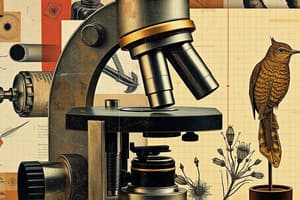Podcast
Questions and Answers
What is the function of the eyepiece or ocular lens?
What is the function of the eyepiece or ocular lens?
- To magnify the specimen (correct)
- To provide a stable platform
- To move the stage up or down
- To hold the tube in place
What does the coarse adjustment knob do?
What does the coarse adjustment knob do?
Moves the stage up or down to focus on the specimen.
What is the purpose of the fine adjustment knob?
What is the purpose of the fine adjustment knob?
To sharpen an image under low and medium power.
What is the revolving nosepiece used for?
What is the revolving nosepiece used for?
What are the magnifications of the objective lenses?
What are the magnifications of the objective lenses?
Where is the stage located on a microscope?
Where is the stage located on a microscope?
Stage clips are used to hold a slide in position on the stage.
Stage clips are used to hold a slide in position on the stage.
What is the function of the diaphragm?
What is the function of the diaphragm?
What does the lamp do in a microscope?
What does the lamp do in a microscope?
What is the function of the arm on a microscope?
What is the function of the arm on a microscope?
What does the base of a microscope provide?
What does the base of a microscope provide?
What is the role of the tube in a microscope?
What is the role of the tube in a microscope?
Where are the condenser lenses located?
Where are the condenser lenses located?
Flashcards are hidden until you start studying
Study Notes
Parts of a Compound Microscope
-
Eyepiece or Ocular Lens
Magnifies the specimen usually by 10x; the lens you look through. -
Coarse Adjustment Knob
Moves the stage up or down to bring the specimen into focus; the first knob to be used for focusing. -
Fine Adjustment Knob
Sharpen images under low and medium power; essential for high power focusing. -
Revolving Nosepiece
Mounts the objective lenses; allows selection between low, medium, or high power lenses by rotation. -
Objective Lenses
Three lenses for magnification: Low (4x), Medium (10x), and High (40x). -
Stage
The flat platform where slides are placed for observation; should be kept dry. -
Stage Clips
Secure slides in position on the stage to prevent movement during observation. -
Diaphragm
Contains holes of varying sizes to control the amount of light passing through the specimen. -
Lamp
Provides light necessary for viewing specimens; microscopes without a lamp may use mirrors to reflect natural light. -
Arm
Holds the microscope's tube in place and serves as the handle for carrying the microscope. -
Base
Offers a stable support for the entire microscope structure. -
Tube
Separates the ocular lens from the objective lenses, ensuring proper distance for effective magnification. -
Condenser Lenses
Located beneath the stage, these lenses help concentrate light onto the specimen for better visibility.
Studying That Suits You
Use AI to generate personalized quizzes and flashcards to suit your learning preferences.




